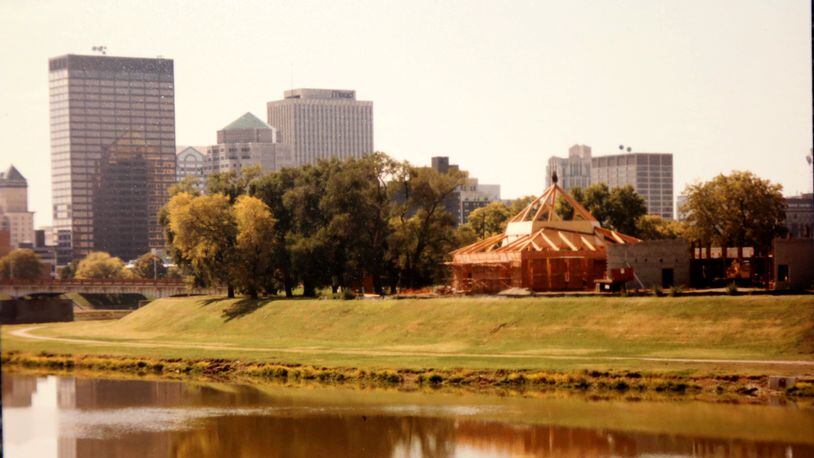History of Temple Israel
1850 Twelve Jews, under the leadership of Joseph Lebensburger, met in the old Dayton Bank Building to form a Hebrew Society dedicated to worship and perpetuation of their joint heritage.
1854 The Hebrew Society incorporated as Kehillah Kodesh B'nai Yeshurun.
1860 The rapidly growing congregation moved to larger quarters near First and Main streets. Congregation purchased its first home, a former Baptist church at the northeast corner of 4th and Jefferson streets, for $4,500.
1893 The old synagogue was sold and a new house of worship constructed at the corner of First and Jefferson streets.
1913 The area around K.K. B'nai Yeshurun was heavily flooded and great damage occurred to the synagogue during the Dayton Flood.
1925 Under the spiritual leadership of Rabbi Samuel S. Mayerberg, a new structure was built at the corner of Salem and Emerson avenues with a sanctuary seating 600, a social hall, classrooms, offices and a kitchen. The congregation's name was changed to Temple Israel.
1953 During the tenure of Rabbi Selwyn D. Ruslander (who served Temple Israel from 1947 until his death in 1969), a modern sanctuary was built and directly connected to the original building.
1973 Rabbi P. Irving Bloom became rabbi, and many innovations followed: a new Religious School Hebrew curriculum; Focus on Friday programs with enriching speakers during the year; Scholar-in-Residence programs with Temple Beth Or and Beth Abraham Synagogue; adult Jewish studies classes; lay-led summer services with Beth Abraham.
1994 The congregation moved into its new home at on Riverside Drive.
1997 Rabbi Bloom retired, and Rabbi Marc Gruber became Temple's religious leader and during his tenure introduced adult B'not Mitzvah classes; worship reform; participation in Synagogue 2000, and other innovative programs.
2000 Temple Israel celebrated its Sesquicentennial with a full year of exciting religious, cultural, social and social action programs that involved hundreds of congregants as well as the local community.
2002 Rabbi Gruber left Temple to become Rabbi at Central Synagogue of Nassau County in Rockville Center, New York. Rabbi Michael Remson stepped in to lead us through the transition to our next Rabbi.
2003 Rabbi David Sofian joined Temple Israel to build on the legacy of those who have come before and to create a rich and vibrant future for the congregation.
2008 Temple dedicates a Torah commissioned by the congregation in which members have inscribed letters, fulfilling the commandment to write a Torah during their lifetimes.
2011 Temple hosts its first Jewish Cultural Festival.
2015 Rabbi David Sofian retires and Interim Rabbi Ilene Bogosian joins the congregation.
Source: Temple Israel
For the 20th year, congregants of Dayton’s Temple Israel are commemorating the Jewish High Holy Days in their synagogue overlooking the Great Miami River. Earlier this week, they celebrated Rosh Hashanah (the Jewish New Year) and on Sept. 22-23 will be observing Yom Kippur (known as the Day of Atonement).
Years of planning and construction took place before Temple Israel at Riverbend was officially dedicated May 5, 1995. The congregation, which traces its roots to 1850, had worshipped in five locations in the city before the decision was made to leave the synagogue at Emerson and Salem avenues and build a new home.
A shrinking congregation, predicted by planners, was part of the reason the temple looked for a new site. Twenty years ago 700 to 750 families were part of the congregation. Today the temple is home to 450 families.
Rabbi P. Irving Bloom, who served the synagogue from 1973 to 1997, now lives in Atlanta and said leaving the old sanctuary filled the congregation with emotion because it was the site of many significant family events over the years.
“It was with a sense of anticipation and a sense of emotional longing for the old place that we made the decision to move,” he said.
The 12-acre piece of land, the former home of the Riverbend Arts and Cultural Center, was an empty parking lot surrounded by trees that had become an overnight camp for the homeless when it was identified as the new location for Dayton’s oldest Jewish congregation.
David Goldenberg, past president of Temple Israel and the steering committee chairman for the project at the time, said there were numerous connections that drew them to the site along the river bank. “The idea of being center in an outdoor space was important. It gives a sense of openness and contact with nature versus being surrounded by other buildings,” he said.
There was a “sense of spirituality connected with that beautiful spot,” said Rabbi Bloom. “The river, the grounds and being both urban and suburban at the same time, it seemed to just speak to us.”
New York architect Malcolm Holzman designed the building to “reflect, in built form, the 3,000 years of Judaic tradition in structure that looked to the future.”
The clay-tile exterior is intended to mimic Jerusalem stone and the curving wall and roof line along the back is reminiscent of the movement of the river.
Goldenberg said they needed a building that could better serve the congregation geographically as well as provide accessibility. Planners were also looking ahead to innovative ideas for the future. ”We can do outdoor things now that we couldn’t do,” he said of the Jewish Cultural Festival recently held for the fifth year. “The festival is becoming an increasingly wonderful event.”
Each succeeding group of leaders has found innovative ways for the congregation to come together and use the space inside and out of the synagogue, said Goldenberg. “The Jewish religion is not building-centric, it’s home-centric,” he said. “The building has worked well. I think we built something that can last another generation. “
Rabbi Bloom said the building helped move the congregation into the 21st-century, “The building spoke to our hearts as well as our minds as we engaged in worship and study. Temple Israel has always been part of the total community.”
About the Author
